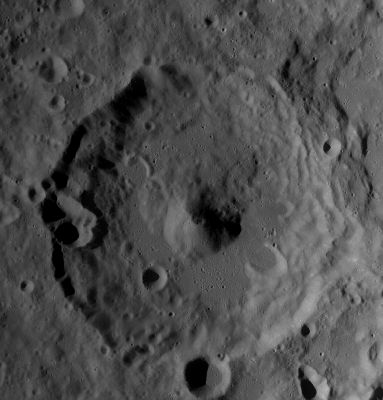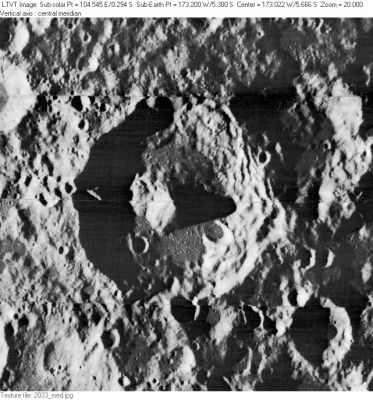Difference between revisions of "Icarus"
| (3 intermediate revisions by the same user not shown) | |||
| Line 5: | Line 5: | ||
|- | |- | ||
| | | | ||
| − | [http://www.lpod.org/coppermine/displayimage.php?pid=5075&fullsize=1 [[Image: | + | [http://www.lpod.org/coppermine/displayimage.php?pid=5075&fullsize=1 [[Image:Normal_icarus.jpg|external image normal_icarus.jpg]]]<br /> |
| | | | ||
| − | [http://www.lpod.org/coppermine/displayimage.php?pid=3675&fullsize=1 [[Image: | + | [http://www.lpod.org/coppermine/displayimage.php?pid=3675&fullsize=1 [[Image:Normal_Icarus_LO-II-033M_LTVT.JPG|external image normal_Icarus_LO-II-033M_LTVT.JPG]]]<br /> |
|} | |} | ||
'''Left:''' ''[http://lroc.sese.asu.edu/index.html LROC]'' WAC image No. [http://wms.lroc.asu.edu/lroc/view_lroc/LRO-L-LROC-2-EDR-V1.0/M118634453ME M118634453ME]. Calibrated by [http://ltvt.wikispaces.com/Utility+Programs#WAC_Viewer LROC_WAC_Previewer].<br /> '''Right:''' ''[http://lpod.org/coppermine/displayimage.php?pos=-3675 LO-II-033-M]''<br /> <div id="toc"> | '''Left:''' ''[http://lroc.sese.asu.edu/index.html LROC]'' WAC image No. [http://wms.lroc.asu.edu/lroc/view_lroc/LRO-L-LROC-2-EDR-V1.0/M118634453ME M118634453ME]. Calibrated by [http://ltvt.wikispaces.com/Utility+Programs#WAC_Viewer LROC_WAC_Previewer].<br /> '''Right:''' ''[http://lpod.org/coppermine/displayimage.php?pos=-3675 LO-II-033-M]''<br /> <div id="toc"> | ||
| − | + | <br /> | |
| − | |||
==Images== | ==Images== | ||
[http://www.lpod.org/coppermine/thumbnails.php?album=search&type=full&search=Icarus LPOD Photo Gallery] [http://www.lpi.usra.edu/resources/lunar_orbiter/bin/srch_nam.shtml?Icarus%7C0 Lunar Orbiter Images] [http://www.lpi.usra.edu/resources/apollo/search/feature/?feature=Icarus Apollo Images]<br /> | [http://www.lpod.org/coppermine/thumbnails.php?album=search&type=full&search=Icarus LPOD Photo Gallery] [http://www.lpi.usra.edu/resources/lunar_orbiter/bin/srch_nam.shtml?Icarus%7C0 Lunar Orbiter Images] [http://www.lpi.usra.edu/resources/apollo/search/feature/?feature=Icarus Apollo Images]<br /> | ||
| − | * [http://www.lpi.usra.edu/resources/apollo/frame/?AS17-162-24106 AS17-162-24106] is one of the orbital photographs which was made with a NIKON camera (35 mm), this during the last Apollo mission in December 1972. It shows '''Icarus''' near the curved horizon, looking north (note '''Icarus''''s pronounced "[ | + | * [http://www.lpi.usra.edu/resources/apollo/frame/?AS17-162-24106 AS17-162-24106] is one of the orbital photographs which was made with a NIKON camera (35 mm), this during the last Apollo mission in December 1972. It shows '''Icarus''' near the curved horizon, looking north (note '''Icarus''''s pronounced "[[Alpetragius|Alpetragius]]-like" peak!). The crater in front of '''Icarus''' is [[Amici|Amici]]. Compare this NIKON-photograph with the ''LAC 86'' map in the ''[[Clementine%20Atlas|Clementine Atlas]]''. Research: Danny Caes. |
* [http://www.hq.nasa.gov/office/pao/History/alsj/a11/AS11-44-6606.jpg AS11-44-6606] is one of the most remarkable orbital Hasselblads made during the mission of Apollo 11, because it shows the illuminated central peak of '''Icarus''', while most of '''Icarus''''s floor is in pitch black shadow (evening terminator). Research: Danny Caes. | * [http://www.hq.nasa.gov/office/pao/History/alsj/a11/AS11-44-6606.jpg AS11-44-6606] is one of the most remarkable orbital Hasselblads made during the mission of Apollo 11, because it shows the illuminated central peak of '''Icarus''', while most of '''Icarus''''s floor is in pitch black shadow (evening terminator). Research: Danny Caes. | ||
<br /> | <br /> | ||
==Maps== | ==Maps== | ||
| − | ''([ | + | ''([[LAC%20zone|LAC zone]] 86B3)'' [http://planetarynames.wr.usgs.gov/images/Lunar/lac_86.pdf USGS Digital Atlas PDF]<br /> <br /> |
==Description== | ==Description== | ||
<br /> | <br /> | ||
| Line 26: | Line 25: | ||
* IAU page: [http://planetarynames.wr.usgs.gov/Feature/2642 Icarus] | * IAU page: [http://planetarynames.wr.usgs.gov/Feature/2642 Icarus] | ||
| − | * From the shadows in [http://www.lpi.usra.edu/resources/lunarorbiter/frame/?2033 LO-II-033M], '''Icarus''' appears to be about 4.6-4.7 km deep. The shadow from the ~27 km diameter central peak gives a height difference from peak to shadow tip of 4.1 km. Since the shadow tip appears to fall slightly up the crater wall, the height of the peak above the floor may be slightly higher. The oblique images taken from Apollo suggest the possibility the central peak may be taller than the rim. ''Note: although the pointy shadow from the central peak appears to the eye to be longer than the broader shadow from the west rim, measurement shows the two to be essentially the same length -- however, the sun angle over the peak is lower, so a shadow of equal length represents a smaller height difference -- that is, the equal shadows suggest the peak is less tall than the west rim.''<span class="membersnap">- | + | * From the shadows in [http://www.lpi.usra.edu/resources/lunarorbiter/frame/?2033 LO-II-033M], '''Icarus''' appears to be about 4.6-4.7 km deep. The shadow from the ~27 km diameter central peak gives a height difference from peak to shadow tip of 4.1 km. Since the shadow tip appears to fall slightly up the crater wall, the height of the peak above the floor may be slightly higher. The oblique images taken from Apollo suggest the possibility the central peak may be taller than the rim. ''Note: although the pointy shadow from the central peak appears to the eye to be longer than the broader shadow from the west rim, measurement shows the two to be essentially the same length -- however, the sun angle over the peak is lower, so a shadow of equal length represents a smaller height difference -- that is, the equal shadows suggest the peak is less tall than the west rim.''<span class="membersnap">- JimMosher</span> |
<br /> | <br /> | ||
==Nomenclature== | ==Nomenclature== | ||
* Named for [http://en.wikipedia.org/wiki/Icarus_%28mythology%29 Icarus], a character in Greek Mythology. Icarus was famous for his death by falling into the Icarian Sea when he flew too close to the sun, melting the wax holding his artificial wings together. | * Named for [http://en.wikipedia.org/wiki/Icarus_%28mythology%29 Icarus], a character in Greek Mythology. Icarus was famous for his death by falling into the Icarian Sea when he flew too close to the sun, melting the wax holding his artificial wings together. | ||
| − | * '''Icarus''' was among the long list of farside names approved by the IAU in 1970 and published in [ | + | * '''Icarus''' was among the long list of farside names approved by the IAU in 1970 and published in [[Menzel%2C%201971#ICARUS|Menzel, 1971]]. It is one of the very few craters named after a mythological figure (a practice that is no longer allowed), although the biographical information regards him as a legendary figure who can (possibly) be placed in the second millennium BC. |
* In the planning for Apollo 8, the first manned circumlunar mission (1968), this crater (which did not then have an official name) was referred to informally as "'''Low'''" (source: [http://www2.lpod.org/wiki/September_9,_2007 Phil Stooke's LPOD]). | * In the planning for Apollo 8, the first manned circumlunar mission (1968), this crater (which did not then have an official name) was referred to informally as "'''Low'''" (source: [http://www2.lpod.org/wiki/September_9,_2007 Phil Stooke's LPOD]). | ||
| − | * '''Icarus''' was also the unofficial name of a small craterlet near the landing site of Apollo 15's LM ''Falcon''. This small craterlet is located at the '''North Complex''', see: [ | + | * '''Icarus''' was also the unofficial name of a small craterlet near the landing site of Apollo 15's LM ''Falcon''. This small craterlet is located at the '''North Complex''', see: [[Apollo%2015%20site|Apollo 15 site]]. |
<br /> | <br /> | ||
==LPOD Articles== | ==LPOD Articles== | ||
| Line 40: | Line 39: | ||
<br /> <br /> | <br /> <br /> | ||
---- | ---- | ||
| − | [ | + | [[Alphabetical%20Index|Named Features]] -- Prev: [[Ibn-Rushd|Ibn-Rushd]] -- Next: [[Ideler|Ideler]]<br /> |
---- | ---- | ||
| − | + | </div> | |
Latest revision as of 20:18, 16 April 2018
Contents
Icarus
| Lat: 5.58°S, Long: 173°W, Diam: 93.73 km, Depth: km, Rükl: (farside) | |
Right: LO-II-033-M
Images
LPOD Photo Gallery Lunar Orbiter Images Apollo Images
- AS17-162-24106 is one of the orbital photographs which was made with a NIKON camera (35 mm), this during the last Apollo mission in December 1972. It shows Icarus near the curved horizon, looking north (note Icarus's pronounced "Alpetragius-like" peak!). The crater in front of Icarus is Amici. Compare this NIKON-photograph with the LAC 86 map in the Clementine Atlas. Research: Danny Caes.
- AS11-44-6606 is one of the most remarkable orbital Hasselblads made during the mission of Apollo 11, because it shows the illuminated central peak of Icarus, while most of Icarus's floor is in pitch black shadow (evening terminator). Research: Danny Caes.
Maps
(LAC zone 86B3) USGS Digital Atlas PDF
Description
Wikipedia
Additional Information
- IAU page: Icarus
- From the shadows in LO-II-033M, Icarus appears to be about 4.6-4.7 km deep. The shadow from the ~27 km diameter central peak gives a height difference from peak to shadow tip of 4.1 km. Since the shadow tip appears to fall slightly up the crater wall, the height of the peak above the floor may be slightly higher. The oblique images taken from Apollo suggest the possibility the central peak may be taller than the rim. Note: although the pointy shadow from the central peak appears to the eye to be longer than the broader shadow from the west rim, measurement shows the two to be essentially the same length -- however, the sun angle over the peak is lower, so a shadow of equal length represents a smaller height difference -- that is, the equal shadows suggest the peak is less tall than the west rim.- JimMosher
Nomenclature
- Named for Icarus, a character in Greek Mythology. Icarus was famous for his death by falling into the Icarian Sea when he flew too close to the sun, melting the wax holding his artificial wings together.
- Icarus was among the long list of farside names approved by the IAU in 1970 and published in Menzel, 1971. It is one of the very few craters named after a mythological figure (a practice that is no longer allowed), although the biographical information regards him as a legendary figure who can (possibly) be placed in the second millennium BC.
- In the planning for Apollo 8, the first manned circumlunar mission (1968), this crater (which did not then have an official name) was referred to informally as "Low" (source: Phil Stooke's LPOD).
- Icarus was also the unofficial name of a small craterlet near the landing site of Apollo 15's LM Falcon. This small craterlet is located at the North Complex, see: Apollo 15 site.
LPOD Articles
Bibliography
Named Features -- Prev: Ibn-Rushd -- Next: Ideler

